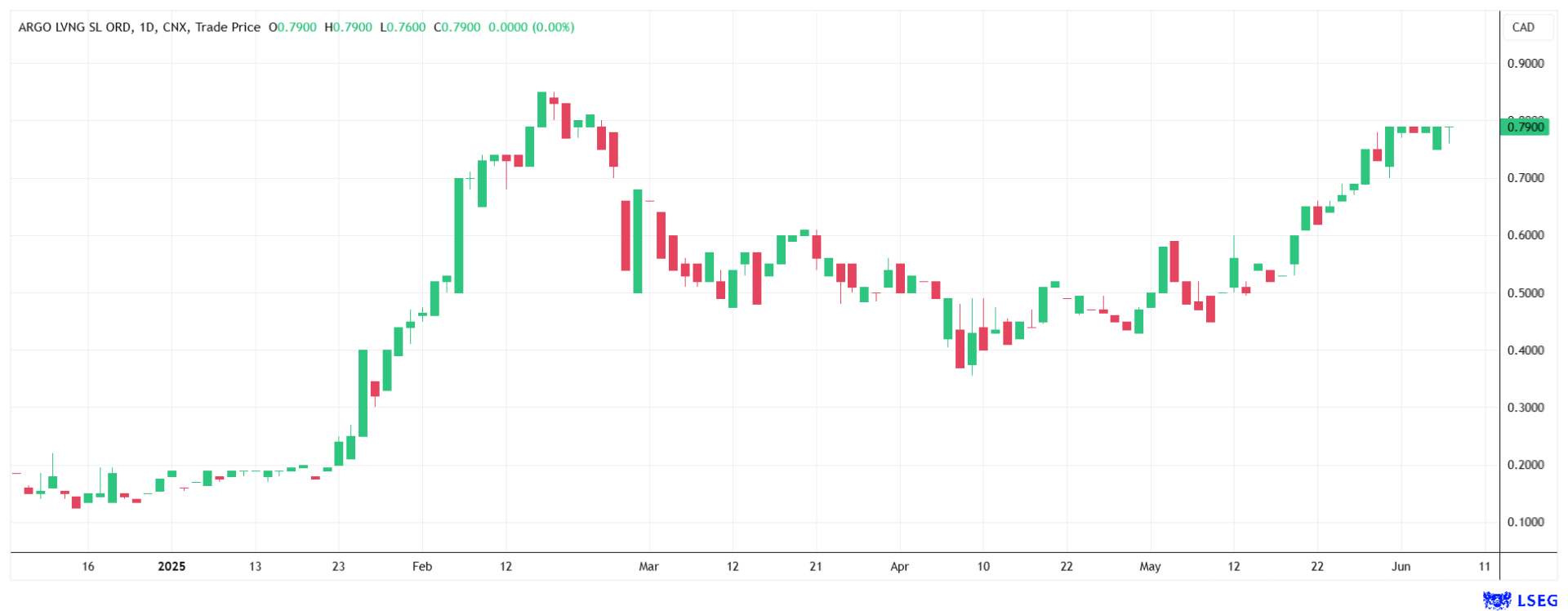June 9th, 2025 | 07:10 CEST
Argo Living Soils – The silent pioneer in the trillion-dollar race for green concrete and asphalt
While the construction industry worldwide is searching for solutions to improve its carbon footprint, a Canadian cleantech company is making a remarkable strategic shift. Argo Living Soils, previously rooted in the agricultural sector, is positioning itself through a key partnership with Graphene Leaders Canada Inc. (GLC) in the emerging market for graphene-optimized concrete and asphalt, a field experiencing exponential growth. This calculated entry into a billion-dollar market opens up fascinating prospects for investors. We analyze why the combination of market dynamics and a clever business model deserves much more attention.
time to read: 4 minutes
|
Author:
Armin Schulz
ISIN:
ARGO LIVING SOILS CORP | CA04018T3064
Table of contents:
Author
Armin Schulz
Born in Mönchengladbach, he studied business administration in the Netherlands. In the course of his studies he came into contact with the stock exchange for the first time. He has more than 25 years of experience in stock market business.
Tag cloud
Shares cloud
A market at a crossroads: Pressure meets innovation
The global concrete industry is under massive pressure to transform. With 14 billion cubic meters used annually, it accounts for 8% of global CO2 emissions - more than all air traffic. At the same time, regulatory pressure is growing. California, the EU, and several other countries are already calling for "net zero" building materials by 2050.
This presents a huge market opportunity. Graphene concrete and asphalt not only reduce CO2 emissions by up to 50% but also significantly extend the service life of infrastructure. Studies show up to 140% higher compressive strength and 80% improved flexural strength, which is particularly important in areas with extreme temperatures or significant temperature differences, as well as a reduction in water permeability of approximately 75%.

The effect is economically revolutionary: less material usage, lower maintenance costs, and longer service life. While the global graphene market was still at USD 290 million in 2024, market researchers at the IMARC Group see the global graphene market reaching USD 7.8 billion by 2033, corresponding to annual growth of around 39% from 2025, driven by the construction industry.
Argo's strategic vision: Partnership, scaling, vision
Argo Living Soils does not rely on its own production but instead on an elegant three-phase model:
- Technology alliance instead of in-house development:
The partnership with Graphene Leaders Canada (GLC) gives Argo access to patented liquid dispersions that offer a competitive advantage. While competitors struggle with graphene powders, GLC's liquid formulations enable homogeneous admixtures. This is the only way the graphene particles can develop their full effect in concrete. GLC's expertise is validated by various patents and intellectual property rights. Robert Intile, CEO of Argo, commented, "This project builds on our commitment to sustainable innovation and aims to deliver stronger, more environmentally friendly infrastructure solutions that meet the evolving needs of the construction industry."
Here, you will find a video about the partner Graphene Leaders Canada.
- Gradual market development:
In the first step, Argo is deliberately focusing on Canada, which pumps billions into repairing frost-damaged roads every year, as an ideal test field. This concrete and asphalt market alone offers a potential worth several billion US dollars. Success here will serve as a springboard for global scaling. The Company is cleverly circumventing possible US tariffs with its US-based ARGO Green Concrete Solutions. Licensing models or joint ventures with building material giants are being considered to generate profits. This minimizes capital requirements.
- Asset-light philosophy:
The Company's philosophy is "We make products better – not products." Argo acts as a solutions provider, not a manufacturer. In the long term, the Company aims to optimize other industries with innovative graphene technology.
The race: Why timing and positioning matter
There are companies in Europe that are already using graphene-modified concrete variants. But Argo and GLC have two trump cards up their sleeves. The first is liquid dispersion instead of powder, which leads to higher material efficiency and is easier to process. This is a unique selling point. Second, local regulations in Canada favor climate-friendly infrastructure solutions, and there is significantly less bureaucracy than in the EU.
The critical phase is currently underway. Laboratory tests in Alberta are validating performance under real-world conditions. If the dispersion technology for graphene nanoplatelets can be successfully used in concrete and asphalt, nothing will stand in the way of commercialization. The biggest argument remains sustainability. If the technology doubles the service life of roads, for example, not only will costs be halved, but the carbon footprint will also be reduced.
Investment perspective: Why this market ticks differently
Unlike hype technologies, graphene-reinforced concrete and asphalt offer clear value drivers:
-
Regulatory tailwind: CO₂ taxes and green public procurement policies are forcing the use of sustainable building materials.
-
Cost savings potential: Higher material costs of approximately 5-8% are more than offset by 20-30% lower cement requirements and longer life cycles.
-
Economies of scale: The existing concrete infrastructure enables rapid market penetration without disruptive new investments.
Argo also benefits from good timing! The valuation still primarily reflects the old agricultural business. Nevertheless, the share price has recently risen to CAD 0.79, close to its all-time high. If the field tests in Alberta prove convincing, the market could reassess the strategic change. The course has been set.

Argo Living Soils occupies more than just a niche market with its focus on graphene-optimized concrete and asphalt. It is positioning itself at the epicenter of an industrial revolution. Its partnership with GLC offers technological credibility, while its scalable B2B model minimizes capital risks. Although the project is still in its infancy, the market potential is enormous. This is mainly because a growing billion-dollar sector under sustainability pressure is actively seeking such solutions. For investors, this strategic shift from a biochar specialist to a construction industry enabler could open a rare early-stage window into a fundamentally driven megatrend. The upcoming test results will be decisive – but the strategic direction already deserves close attention.
Conflict of interest
Pursuant to §85 of the German Securities Trading Act (WpHG), we point out that Apaton Finance GmbH as well as partners, authors or employees of Apaton Finance GmbH (hereinafter referred to as "Relevant Persons") may hold shares or other financial instruments of the aforementioned companies in the future or may bet on rising or falling prices and thus a conflict of interest may arise in the future. The Relevant Persons reserve the right to buy or sell shares or other financial instruments of the Company at any time (hereinafter each a "Transaction"). Transactions may, under certain circumstances, influence the respective price of the shares or other financial instruments of the Company.
In addition, Apaton Finance GmbH is active in the context of the preparation and publication of the reporting in paid contractual relationships.
For this reason, there is a concrete conflict of interest.
The above information on existing conflicts of interest applies to all types and forms of publication used by Apaton Finance GmbH for publications on companies.
Risk notice
Apaton Finance GmbH offers editors, agencies and companies the opportunity to publish commentaries, interviews, summaries, news and the like on news.financial. These contents are exclusively for the information of the readers and do not represent any call to action or recommendations, neither explicitly nor implicitly they are to be understood as an assurance of possible price developments. The contents do not replace individual expert investment advice and do not constitute an offer to sell the discussed share(s) or other financial instruments, nor an invitation to buy or sell such.
The content is expressly not a financial analysis, but a journalistic or advertising text. Readers or users who make investment decisions or carry out transactions on the basis of the information provided here do so entirely at their own risk. No contractual relationship is established between Apaton Finance GmbH and its readers or the users of its offers, as our information only refers to the company and not to the investment decision of the reader or user.
The acquisition of financial instruments involves high risks, which can lead to the total loss of the invested capital. The information published by Apaton Finance GmbH and its authors is based on careful research. Nevertheless, no liability is assumed for financial losses or a content-related guarantee for the topicality, correctness, appropriateness and completeness of the content provided here. Please also note our Terms of use.




